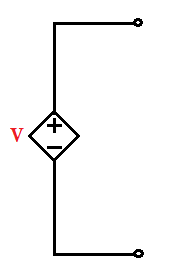An electric
circuit is nothing but an interconnection of elements in such a way that they
serve a definite purpose. Here, we are talking about the world ‘element’ which
happens to be the basic building block of the circuit.
On the basis
of energy, circuit elements can be classified into two types:
1. Active
2. Passive
ACTIVE
ELEMENT –
An active
element is one which is capable of generating energy of its own.
Eg:
Generators, batteries and op-amps etc.
PASSIVE
ELEMENT –
A passive
element is one which cannot generate energy of its own.
Eg:
Resistors, capacitors and inductors.
As passive
elements have been explained before in previous posts; you can study them in
detail by seeing their respective posts. In this article, our main aim is to
study in detail about active elements. So, let’s do it my friends!
The most
important active elements are generally voltage sources or current sources.
Speaking particularly about voltage and current sources, they can be grouped
as: Independent and Dependent sources.
WHAT IS AN
INDEPENDENT SOURCE?
An
independent source is an active element that provides a specific voltage or
current to the circuit and is completely independent of other circuit
variables. The term ‘circuit variable’ refers to value of current or voltage in
a circuit that is associated with the final value of the source. However,
independent sources are independent of such circuit variables.
The symbol
of independent sources is generally represented by a circle. Symbols for
independent voltage and current sources are shown in the figure below.
 | |
| INDEPENDENT VOLTAGE SOURCE |
 |
| INDEPENDENT CURRENT SOURCE |
WHAT IS A
DEPENDENT SOURCE?
A dependent
source is an active element in which the ability of source to deliver voltage
or current is controlled by a circuit variable.Dependent
sources are usually represented by diamond shaped symbols as shown in the
figure below.
Since, the
dependent sources are controlled by the voltage or current (circuit variables)
of some other element in the circuit, and the source can be voltage or current,
it leads to the conclusion that there are four possible types of dependent
sources:-
1. Voltage-controlled voltage source
(VCVS)
2. Current-controlled voltage source
(CCVS)
3. Voltage-controlled current source
(VCCS)
4. Current-controlled current source
(CCCS)
The
application of controlled sources can be seen in the modeling of electronic
elements such as transistors, op-amps and integrated circuits. These devices
are used in amplifiers having a pair of input terminals and a pair of output
terminals. The four kinds of dependent sources with their equivalent circuits
are shown in the figure:
 |
| Voltage-controlled voltage source (VCVS) |
 |
| Voltage-controlled current source (VCCS) |
 |
| Current-controlled voltage source (CCVS) |
 |
| Current-controlled current source (CCCS) |
An example of voltage controlled current source is shown in the figure below:
Here, 2V1
is the value of the current provided by the current source. One must not
confuse with the idea that if voltage is multiplied by a constant, then the
value of that source will be in volts. 2V1 A is a current source.
The key to
identify these sources is to keep in mind that a voltage source is shown by
polarities (+ -) in its symbol, while a current source is shown by an arrow,
irrespective of what it depends on.



